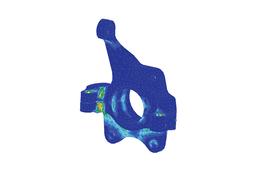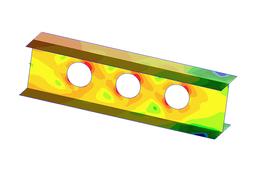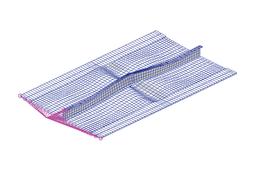
Multidiscipline Simulation Software Supplier, Linear and Nonlinear Finite Element Analysis (FEA), Control Systems Simulation and more
Improve the acoustic performance of your products with the multidisciplinary approach of N&V studies
Structural vibration can be a source for many product related problems; it can cause fatigue and durability problems as well as adverse reactions to the user or bystanders in the form of undesirable vibrations that can be felt or heard. As well, undesired structural vibrations can prevent products from operating as required and potentially becoming a safety concern.
NVH (Noise, Vibration, and Harshness) or N&V (Noise and Vibration), this problem is one of the most often directly perceived quality traits of a product, and is therefore one of the most sought after targets for performance by the product development team to help differentiate themselves from competition.
With leading FEA and MBD (multi body dynamics) capabilities from MSC, users can simulate and predict how a component or system will vibrate under varying operating conditions; for example how a driver or passenger of a car driving down the road can perceive the engine sound at cruising speed or under acceleration and at the same time perceive the feel and the noise generated as the car runs over a pot hole.
MSC Software is used for many types of N&V simulations:
- Acoustic panel modal participation factors
- Analysis of fully trimmed models
- Automated component modal synthesis (ACMS)
- Complex Eigenvalues
- Dynamic design optimization
- Flexible bodies for Multibody dynamics
- Frequency response analysis
- Frequency response function (FRF)
- FRF based assembly (FBA)
- Transfer path analysis
- Load identification
- Loads: Frequency or time dependent force, displacement, velocity, and acceleration
- Modal participation factor
- Multimodel and multidiscipline optimization
- Normal mode analysis
- Random response analysis
- Superelements
- Transient response analysis
Industry Uses:
- Aerospace & Defense: Aeroacoustics/fan noise, interior compartments, insulation for engines, structural damping systems.
- Automotive: Transmission, exhaust, brakes, planetary gearsets, chain drives, cowltop vent panel, powertrain, engine mounts, transmission mount, rear axle elastic parts, front axle elastic parts.
- Heavy Equipment: Skid steer loaders, viscoelastic mounts, pipe suspension systems, vehicle dynamics and chassis, cab suspensions.
Structural Vibrations

APPLIED IMPULSE LOADING FOR A TIME NVH ANALYSIS

ATV VIBRATION ANALYSIS
Understanding the structural vibration characteristics of a component or system typically requires the engineer to understand both the natural vibration characteristics of the structure, also known as vibration modes, and how the structure responds to external loading factors, typically referred to frequency response and transient loading.
MSC’s NVH solutions provide capabilities for linear and non-linear modal, transient and frequency response analyses for structural components, systems and mechanical assemblies. When noise or durability are a concern, this vibration information can then be used to perform coupled acoustics predictions for interior or exterior noise, or it can be used to perform product fatigue predictions, using the detailed, vibratory and transient loading histories obtained in the vibration simulation.

ACOUSTIC ANALYSIS OF A MUFFLER

ACOUSTIC RADIATION ANALYSIS OF AN ENGINE

INTERIOR ACOUSTICS EXAMPLE
MSC offers proven solutions and techniques for simulating and predicting what are typically called internal and external acoustics.
For intenal acoustics MSC provides a coupled Fluid-Structure Interaction simulation which calculates the pressure inside a bounded domain. This is used to solve for sound pressure levels experienced by the occupants. For exterior acoustics, the solution provides a structural vibration coupling with exterior acoustics simulation techniques. This capability is used to analyze the sound field radiated by a vibrating structure in a single coupled vibro-acoustic analysis.
With the use of infinite elements, the need for large meshes of the field around acoustic sources is eliminated. In addition to the sound pressure level calculations, MSC provides analysis techniques that allow the engineer to identify which components in an assembly are contributing the most to a particular noise, something referred to as panel participation.


FRF BASED APPROACH USED TO ANALYZE ENGINE AND TIRE LOADS
A typical challenge in NVH analysis is identifying the path of energy flow from source to a point of interest.
It is beneficial to understand the source of undesired vibration or noise well in advance of vehicle assembly. MSC provides a Frequency Response Function (FRF) based methodology to help address this need.
FRF represents the frequency response of components due to unit loads at a given frequency. The FRFs of components can then be combined to yield the FRFs of assemblies of these components. An advantage of this approach is that it lends itself to transfer path analysis (TPA). Through TPA, users can trace the energy flow from source to receiver. This allows identification of critical paths and noise sources. For instance, in the top left picture, the source of noise is the engine and in the bottom picture, the noise source is due to tire loads. Thus, to understand and improve vehicle NVH, it is necessary that the engineer perform a full system analysis, and MSC Nastran enables this with its scalable, application specific solvers.
Large Model and Assembly Simulation

CONNECTORS ARE SPECIFIED BETWEEN THE TRIM BODY AND THE SUSPENSION AT FOUR LOCATIONS
Critical NVH characteristics, those observed and perceived by the user or bystander, are more often than not related to the design of the entire vehicle.
In order to simulate these behaviors, the simulation model must represent a nearly complete vehicle system, which can lead to very large computer models of the structural and mechanical system assemblies. MSC offers industry proven, high performance methodologies to correctly and efficiently model and simulate these types of models. This includes:
- Techniques for correctly modeling welded, glued, and fastened assemblies, as well as jointed connections.
- ACMS – Automated Component Mode Synthesis for faster, parallelized modal analysis of large models
- External Superelements for use in assembly process to enable logical partitioning of a full-vehicle and reuse of component information.
Related Products:
- Actran Acoustics Powerful Acoustic Simulation Software
- Adams The Multibody Dynamics Simulation Solution
- Marc Advanced Nonlinear Simulation Solution
- MSC Nastran Multidisciplinary Structural Analysis
- MSC Nastran Desktop Multidiscipline Simulation for your Desktop
- Patran Complete FEA Modeling Solution
- SimDesigner CAD-Embedded Multidiscipline Simulation
- SimXpert Fully Integrated Multidiscipline Simulation Solution


































